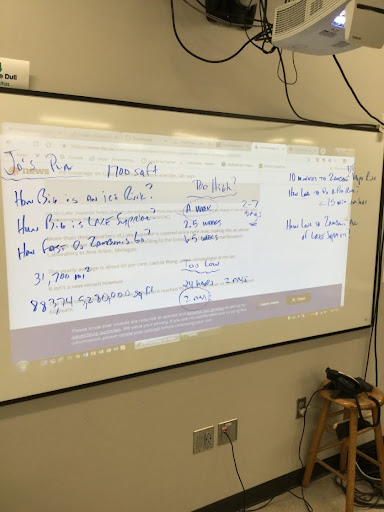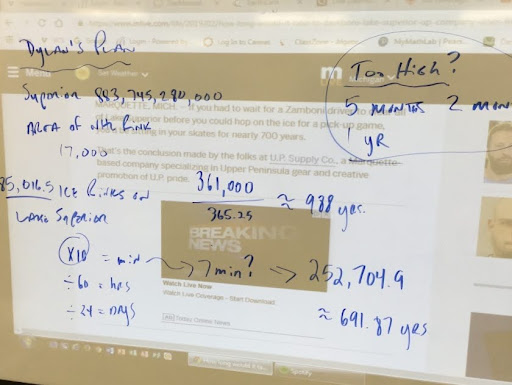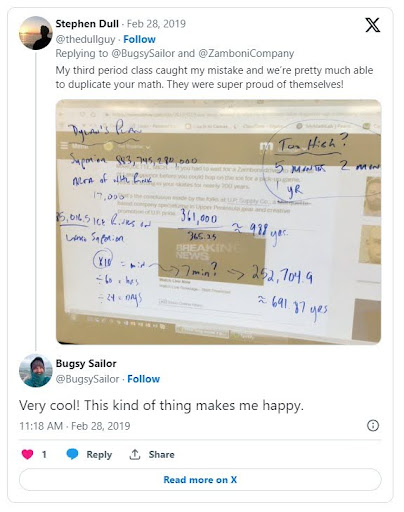“You know Mr. Dull, my mom finds it ironic that my math teacher’s name is ‘Dull.’” — a very observant 4th period student
My school is in the midst of a years-long transition to a project-based learning model. What I’ve learned in that time is that successful implementation requires a new state of mind as well as a change in practice.
In the math classroom, it’s known as “problem-based learning,” where students consider one question for an entire class period or more. There are a multitude of sites where teachers can find resources for what is often called “three-act math,” but once the teacher internalizes the concept, the activities have a tendency to appear out of nowhere and start to write themselves. Here’s an example from a recent activity in my classroom:
“So kids, I’ve got a little piece of video I’d like to share with you.”
We keep the Silver Beach Web Cam up on my screen when we’re mathing most days, so my kids are pretty familiar with frozen lakes. I showed them this story on the current state of Lake Superior ice coverage. Currently, 75% covered, above average for this time of year but not quite the 100% coverage in 1996.
Many of my kids have been to Mackinac Island, so we talked frozen Straits of Mackinac – in the winter snowmobilers can ride across the straits. Also, at this time of year there is a huge Outdoor Pond Hockey Tournament in St. Ignace. I told them I guess they shovel out the rectangles for the rinks, because what are you gonna do, drive a Zamboni out there?
*pause*
But, could we Zamboni a whole lake? (“Oh God Mr. Dull, you’re gonna make us math this aren’t you?”)
I mean, how long would that take? Give me a guess that’s too high. How about a guess that’s too low. Now a Game Show Guess….

They were totally into it. How do I know? The story has gone viral and it’s pretty hard to miss, and none of my kids (in the first two hours anyway) even googled for the answer. Later on when they did, I just said, “I’ll come back to you on that,” and by that time we were far enough along that I could say “let’s check this guy’s math”. Because juniors love proving somebody wrong.
So we went with “Jo’s Plan” (as it came to be known) – if we can find out how big the lake is, and how big a rink is, we can divide to figure out how many rinks it would take to cover the lake. Then all we need to know is how long to resurface a rink. ( One kid in 3rd Hour said, “I’m gonna text my friend and ask. He drives the Zamboni at the rink downtown.” They are very resourceful.)
Let’s go.
We did all kinds of math. Converting square miles to square feet, minutes to hours to days to years, estimating time to resurface a rink (they googled that later too, which was cool).
And we were off by a factor of 10. Came up with 9884 hours or something ridiculous. That “1700 square feet” up there? That’s a problem. Especially since I gave it to them. Ugh.
“The biggest benefit of building a culture of curiosity is you get curious kids.”
But the biggest benefit of building a culture of curiosity is you get curious kids.
“Let’s find the error.” Woah.
They didn’t but my next period class did, which was so cool. The only other tweak was we guessed 10 minutes to do a rink, based on 15 minutes between periods of a Blackhawks game. Turns out it’s more like 7.
“Are three minutes gonna make that much difference you guys?” Times 52 million rinks they are, yeah.
We adjusted the time to do one rink and hit the number almost exactly on the head.

So, a couple of things from today. Students are way more reliant on their devices than they were even a few years ago. It’s hard to get students’attention, let alone keep it. Even district policy and state legislation restricting mobile device use in class doesn’t deter everybody. Habits are hard to break, even in the face of consequences. So, in the midst of “too high/too low” in one class, my most cynical, blase student shouted out “almost 700 years,” tapped the Google app closed and went back to scrolling her Snapchat. I could almost see her huffing her bangs out of her eyes in an act of supreme boredom as she said it.
But 95 % of my kids were hooked. They were helping each other, checking each others’ calculations, and shouting out intermediate steps. I was just sitting back and watching the magic happen. It was awesome.
I capped the day with two things:
We talked about how an astronaut once addressed a group of middle school kids in NW Indiana and challenged them to solve the big problems they’ll face as adults. She talked about manned space flight to Mars and the challenges of keeping humans alive in a tin can at 17,000 mph for six months. Think water and bodily waste. Yep, she went there. They’re middle school kids. They ate it up.
And when I brought up space in class today, one of my kids’ eyes lit up. She told how she had written a paper recently about our current and future plans for space exploration. I totally ceded the floor to her – her enthusiasm lit up my entire room and did more to make the point than I ever could.
A Google search isn’t gonna solve those problems. Thinking deeply about solving insanely crazy problems will.
And, then, a tweet back:
The guy who originally did this math and put it out there for the world to see was scared that his math was wrong. Just like high school kids everywhere.
But he did it anyway.
And then:

Three-Act Math continues to be awesome, and the Internet continues to deliver a steady stream of it right to us. WCYDWT is seemingly alive and well, too. Plus the added bonus of the owner of the UP Supply Company replying to your tweet is kind of cool.
“This kind of thing makes me happy.” A collective “Awwwww!”
And then:

“Mr. Dull, can we solve crazy insane problems and make people happy every Thurdsay?”
Can’t promise anything kid, but it’s tempting.
Resources
Please login or register to claim PGPs.
Alternatively, you may use the PGP Request Form if you prefer to not register an account.



